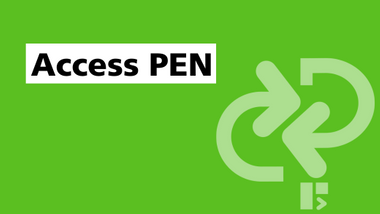If you're new to using PEN, or don't use it regularly, it can take time navigating the system and understanding all that it can offer. This page aims to support members in navigating the PEN system, providing an overview of the different elements availale to users, alongside hints, tips and supporting resources.
Knowledge Pathways
The PEN System is made up of over 200 topics called Knowledge Pathways (KP), which are similar to a chapter in a book. These have been divided into four categories:
- Population Health/Lifestyle
- Health Condition/Disease
- Food/Nutrients
- Professional Practice
There is a wealth of information available within each KP, and this has been divided into specific sections, each with an individual focus and purpose. An overview of each of these sections has been provided below:
Practice Questions
Practice questions are questions that reflect the everyday practice situations faced by dietitians.
The answers to practice questions are provided in the form on Key Practice Points. These are based on a synthesis of the most valid, important and applicable evidence, and provide a succinct evidence-based recommendation or “answer”. Key Practice Points include several sub-categories:
|
Recommendations: |
Recommendations are clear, concise and actionable advice on whether to implement an intervention and, if relevant, under what conditions and how. |
|
Evidence Summary:
|
A succinct summary and critical appraisal of each article used to answer the practice question. Evidence summaries are graded based on the strength of the evidence used to support them. They are graded either by the PEN grading system or by the GRADE system. |
|
Remarks:
|
Remarks describe the justification for the recommendation and present information that would be most useful and relevant to consider in discussion with a client, including defined terms and additional relevant PEN content. |
|
Evidence Statements:
|
A summary of the critically appraised evidence for each referenced article including type of study, the population studied, number of subjects, methods used, main findings and study limitations. |
|
Comments:
|
Includes relevant information to support the Key Practice Point that does not belong in the evidence statements (e.g., food sources of a vitamin, comment on length of trial, social context) that is useful for the acceptability, applicability, and feasibility in the practice context. |
|
Rationale:
|
Allows an explanation of the proposed or known mechanisms of action, reasoning behind the research hypotheses and explanation for theories for the course of action or change. |
|
References:
|
References are hyperlinked to PubMed abstracts, if applicable, or to full articles or practice guidelines, if the PubMed link is not available. |
Summary of Recommendations and Evidence
These provide an overview of all of the Key Practice Points and Recommendations within a Knowledge Pathway according to their evidence grading, all within one handy place.
Backgrounds
These provide the general information or knowledge around a topic, condition or issue. Generally, these come in two formats either clinical or non-clinical, and the information provided will vary dependent on the type.
Within a clinical background, you tend to find information on:
- Aetiology
- Screening
- Diagnosis
- Prevalence
- Symptoms
- Medical treatments
Within non-clinical backgrounds, you may find information on:
- Importance of topic to practice
- Topic overview
- Regulatory issues
- Key resources
Practice Guidance Toolkits
These summarise the practice recommendations for a given topic, and organise them into the steps of the Nutrition Care Process. The Nutrition Care Process (NCP) is the American version of the Model and Process for Nutrition and Dietetic Practice. Though based on the NCP, this follows similar steps to the BDA Model and Process. These will guide you through the steps to providing high quality care within a given specialty.
The Practice Guidance Toolkits navigate through each step of the model from assessment, right through to monitoring and evaluation. With each toolkit tailored directly to the condition outlined in the Knowledge Pathway.
Related Tools and Resources
PEN provides a wealth of related tools and resources within each Knowledge Pathway. There are different types of tools and resources:
PEN Client Handouts
These have been developed specifically by the PEN team or its partner associations. They are consistent with the evidence in the practice questions so you can be certain you are providing your clients with up to date and credible information.
External Tools and Resources
These are links to tools and resources on external websites selected by PEN due to their relevance with the topic area. They are selected based on their consistency with the evidence, authoritative source and currency. These external tools/resources are provided as sources of additional information believed to be reliable and accurate at the time of publication and should not be considered an endorsement of any information, service, product or company. Country-specific resources may not be totally consistent with the evidence presented in PEN, but are included to reflect current country guidelines and practice.
For ease, you can sort the list of resources for each topic area by audience, country and language.
Demonstration
Take a look at the PEN system, and be guided through how to navigate PEN and its key resources in our handy video below:
Supporting Resources
- The PEN Terminology and Features provides a breakdown of all of the key terms and features found within PEN.
- You can familiarise yourself with PEN using the PEN Tours and PEN Video Tutorials, to help you navigate the system.
- If you're unsure about the terminology used in PEN, you can find definitions in the PEN Glossary.
- Check out the PEN Frequently Asked Questions, to answer any questions you may have about accessing, naviagting and making the most out of PEN.




